-
- Indonesia
Map Sumatra Map
|
-

-
-
Map of Southeast Asia
-
|
-
-
|
- More websites from Indonesia and Timor-Leste:
|
-
- latest picture taken: July 7, 2010
- click a picture to see details
|
-
-

|
-
-
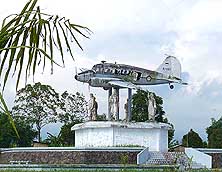
|
-
-

|
- 148
On the day we leave
- Bukittinggi, school children making
- music are parading past “our”
- Benteng-Hotel – a lovely good-bye
|
- 149
On our way out of Bukittinggi,
- we drive past the impressive
- “Pesawat” monument. It is about a
- mysterious plane (Anson 1 ?) of
- the Indonesian Air Force – RI-003
- that is said to have been shot down
- at end of the 1940’s in Malaysia
|
- 150
Friendliness is what we
- encounter everywhere in Sumatra.
- People are waving and smiling at us,
- making us feel welcome as tourists
|
-
- The tension is growing! Will our Papua New Guinea project
ever work out? Despite this still existing uncertainty, we close our camp in Bukittinggi
and continue South to the third and last part of our journey through the island of
Sumatra, towards the shipping port of Jakarta on Java.
It is June 12th, 2010, when we take the Western coastal road, completed only since the end
of the nineties. Before only the completely overloaded Trans Sumatra Highway with its
horror traffic existed. This highway is pretty narrow and curvy with a badly broken-up
road surface and hardly any possibility to overtake. The diesel-powered slow trucks eject
thick black clouds of smoke, so much that nobody has to be surprised to catch a poisoning
while driving behind them. For our first stage to Padang, a one-million-city and the
capital of West Sumatra, we choose the quieter, though 31
miles longer road along the picturesque Singkarak Lake, leading through some areas of
still untouched jungle. It is a lovely drive through a windy and hilly landscape, with a
spectacular climb to 3’300 ft. and a not less spectacular descent to the scorching
heat of the lowland.
|
-
-
-
-

|
-
-

|
-
-
-
-
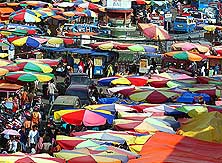
|
- 151
The bazaar of Padang –
- West Sumatra’s capital – is packed
- beneath the sun protecting umbrellas
|
- 152
A minaret and a traditional,
- stylized Minangkabau roof in the
- city center of Padang. The Minang-
- kabau culture of West Sumatra
- is closely connected to Islam
|
- 153
Shoppers and cars struggle
- simultaneously to find a gap through
- the overcrowded bazaar in Padang.
- The view from the top of the adjoining
- parking garage over the roofs of
- colorful umbrellas is just stunning
|
-
- After our comfortable time in the cool climate of Bukittinggi, we have to readapt to the
heat. We are not in the slightest mood for stewing in our own sweat and are therefore
looking for an air conditioned room. The hotel choice in Padang however is very limited
since in September 2009 the majority of the high rising buildings, mainly hotels and
banks, were destroyed by a devastating earthquake. Still today damages and cracks are
visible everywhere. A lot lies still either in debris, is dilapidated or uninhabitable, or
has already been torn town and flattened. 5’000 people lost their lives that day, 100
alone in a hotel. Therefore we are looking for a one story place and check in at the
Padang Hotel. Should it shake again, at least not too much concrete will fall on our
heads.
|
-
-
-
-
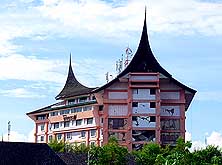
|
-
-

|
-
-
-
-

|
- 154
|
- 155
|
- 156
|
- On September 30th, 2009, Padang was hit by a disastrous earthquake (7.6) that caused the
death of fare more than 1‘000 people.
- Still today, cracks and damages are visible at buildings, hotels and churches. However
many ruins have been already torn down and leveled
|
-
- It smells of sea, fish and of grilled meat when we mingle in the evening with the locals
at the seashore. Being a Sunday, the many restaurants are well visited by families
admiring like us the red ball of the sun disappearing into the Indian Ocean. The view over the endless sea revives
the sensation of vastness, which on this island got a bit lost due to the little open
land, the never ending villages and the overpopulation. The feeling of overcrowding is
here again particularly next morning when we fight our way under the roof of colorful
umbrellas through the busy street bazaar. Emil’s sense for good views leads us once
more to the right place: To the top of the adjoining parking garage. From this vantage we
fully enjoy point the overwhelming market life spreading below us in all its diversity:
Not only shoppers are wandering between the stalls with its clutter of goods; also
motorbikes and cars struggle to find some space to pass. Luckily we intuitively turned
back just in time. With the height of our LandCruiser, undoubtedly we would have got stuck
at some point somewhere between all the umbrellas.
|
-
-

|
-
-

|
-
-

|
- 157
The many colorfully adorned
- and low lying minibuses in Padang
- are an eye-catching sight
|
- 158
Who cares how high the
- load is! At least nobody worries
- in the city of Padang
|
- 159
A palm fringed fishing village
- South of Padang, scarcely halfway to
- Painan, has a touch of the South Pacific
|
-
- After three days we leave Padang before noon and follow further on the coastal road
– still without positive news from PNG. There are only
three weeks left to the shipment. The road condition changes constantly: From highs to
lows, from broken asphalt to deep potholes, interrupted only now and then by a smooth
stretch. The many small tank trucks that crawl on the narrow, windy road are a pain in the
neck, making it difficult to almost impossible to pass. On the other side this section
offers many charming views over bays and the many lagoons along the coast.
|
-
-
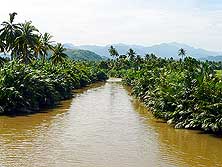
|
-
-
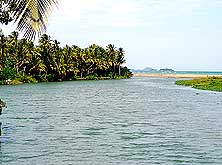
|
-
-

|
- 160
Every once in a while bridges
- cross brown jungle rivers with their
- densely overgrown tropical banks
|
- 161
One of the many mighty
- rivers that flow into the sea
|
- 162
View from Langkisau lookout
- over the perfectly shaped bay of Painan,
- situated about 48 miles South of Padang
|
-
- The highlight arrives at the village of Painan, around 48 miles from Padang. When we
climb the steeply road to the view point, we find a wonderful panorama: To the North the
lagoon with its white sandbank is glowing in the soft evening light. To the South the
roofs of Painan and the perfectly formed bay are spreading below us – really very
impressing! Until late in the evening young motor bikers come and go. They question us
nonstop in their typical Indonesian curiosity until we dismiss our plan to camp here for
the night. Luckily we still find a small hotel room. Hotel guests greet us with
„congratulations, congratulations“ when they realize that we are Swiss. We
didn’t know why until we learnt that Switzerland won 1:0 against Spain at the World
Cup. What a surprise and what a joy!
|
-
-

|
-
-

|
-
-
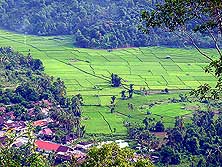
|
- From Langkisau Hill in Painan, we enjoy beautiful views:
|
- 163
To the Northwest:
- Over the glittering lagoon
- and its white sandbank
|
- 164
To the South:
- Over Painan City with some
- towering Minangkabau roofs
|
- 165
To the Northeast:
- Over lush rice paddies, sandwiched
- between the city and the forest
|
-
- At 8am – after a simple breakfast in our hotel room – we are on the road
again. The skies are clear; we seem to drive into a promising but hot day. Our
today’s target is Bengkulu, lying 168 miles to the South, around 7-8 hours driving
time away. On our map the road follows the coast; we soon realize that it doesn’t
mean that we also get to see it. Mostly we catch sporadically just a glimpse of the ocean
and some white sandy beach, and mostly only when we cross one of the many bridges that
span over mighty brown jungle rivers flowing to the sea. To 90% we drive somewhere inland,
between a hundred yards to a few miles away from the sea. That distance is covered mostly
by dense bush, followed further south by endless palm oil plantations. It’s not much
to see so that we hardly take a picture. At least we have some entertainment by the many
animals that wander around at the side of the road with their offspring: From brown cows
with cute calves that haven’t seen the daylight for long, to goats, chickens, dogs
and ducks. Then there are also the geese, which calmly cross the road in a single file and
make us each time fear for their lives.
|
-
-

|
-
-

|
-
-

|
- 166
Fishermen return with their
- catch – South of Painan
|
- 167
A frequent sight: Mosques
- surrounded by lush rice fields
|
- 168
Also water buffaloes feel the
- tropical heat. From the sandbank
- it is easy to jump into the water
|
-
- Somewhere halfway, we leave the province of West Sumatra,
which along with Aceh and South Kalimantan belongs
to Indonesia’s most fundamentalist provinces, and enter the province of Bengkulu. We
reach its same named capital shortly before twilight. It counts around 400’000
people. Strolling around next day, there are many things we like about this city where
former President Soekarno was exiled by the Dutch from 1938-1941: The nicely restored
Marlborough Fort – a former British fortress facing the Indian Ocean, opened to the public in 1984 –
with its shady courtyard where children love to seat on the cannons and where surprisingly
we had to pay only the same entry fee as the locals: Rp: 2’500 (= 30 US Cents).
|
-
-

|
-
-

|
-
-

|
- 169
Red sandstone cliffs, shaped by
- wind and waves, appear halfway between
- Mukomuko and Bengkulu …..
|
- 170
….. a particularly remarkable
- rock, where vegetation already
- has taken roots again
|
- 171
Impressive jungle rivers – here
- before an approaching thunderstorm –
- with densely overgrown banks are
- quite common along the West coast
|
-
- Then we enjoy the white sandy Pajang beach stretching for miles where extended families
play around on Sundays. Stalls offer all kind of snacks and drinks and we hardly believe
our eyes when we see two Sumatra elephants trotting towards our car. They are the
excitement of the day and children love to go for a ride along the beach on their back.
They are old boys earning their living that way as do many working elephants in all kind
of jobs. They are trained in the Kandangsaru Center in "Way Kambas National Park'.
Apparently, they even learnt to play football! Elephants that still live in the wild in
Indonesia are said to be only a few. Of course, we are also thrilled to find two big
supermarkets – Giant and Hypermarket – where since a long time we can buy
“delicacies” like beef salami and smoked beef (there are no pork products on
sale). We also appreciated the luxury Horison Hotel with its swimming pool and sea view
and can take also advantage of the WiFi in the parking lot. And last but not least we like
our spacious air-conditioned and reasonably priced room in the Rega Hotel in the city
center. It is quiet, which is a special bonus in Sumatra.
|
-
-

|
-
-

|
-
-
-
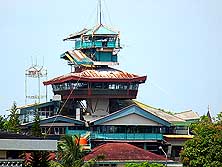
|
- 172
The court yard of the restored
- Marlborough Fort in Bengkulu – a former
- British fortification – is well visited. It is
- also the place where the first President of
- Indonesia, President Sukarno, was sent
- into exile from 1938-1941 by the Dutch
|
- 173
In front of the entrance of
- Fort Marlborough in Bengkulu,
- an elderly lady is selling her
- home cooked food
|
- 174
From Fort Marlborough we
- spot this strange construction in
- Bengkulu – one part of the house
- is built on top of the other.
- Obviously it is a hotel
|
-
- “How many hours do we need to drive to Krui?” we ask at the hotel reception
when we check out after three days. “Seven to eight” is the answer. We guess
that the distance is 140 miles, because none of our three road maps or the internet shows
an accurate indication. From experience we know however that we manage to drive an average
of 17 to 20 miles per hour, depending on the road condition. Therefore we are well off
when we leave at 8am after stocking up some fuel. In Mann, a bigger coastal village, we
make a relaxed lunch break at the sea shore and realize only afterwards with the help of a
few faintly readable milestones that Krui is much further away than we anticipated. The
total distance is 197 miles, not only 140! That means up to four hours more driving time.
As a precaution, we want to bunker more fuel at the next and only gasoline station on the
way. Much to our surprise, it is empty what never happened before.
|
-
-

|
-
-

|
-
-

|
- 175
At Bengkulu with its 400‘000
- people, one fishing boat besides the
- other lines the beach. It’s also the
- capital of the same named province
|
- 176
Panjang beach in Bengkulu is
- stretching for miles. During the week
- it is most of the time deserted
|
- 177
In the quiet Bengkulu lagoon,
- fishermen are fishing from
- bamboo rafts
|
-
- The drive is monotonous. It only becomes more interesting after two-thirds of the
distance, just after changing from the Bengkulu- to the Lampung-Province, right after the
police station. From one instant to the other we find ourselves surrounded by deep jungle
with all its impenetrable foliage. And from one instant to the other the road, brutally
damaged by the heavy trucks, climbs steeply up to 2’000ft. altitude to descend in the
same spectacular manner. Then palm fringed bays appear, one lovelier than the other. And
when simultaneously the sun dives into the sea and the sky gets red, the atmosphere could
not be more stunning. The following half hour we drive in the dark until we reach the
poorly lit sea resort of Krui.
|
-
-
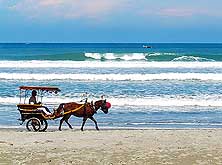
|
-
-

|
-
-

|
- 178
A nostalgic horse carriage
- rolls leisurely along the Pajang
- beach in Bengkulu …..
|
- 179
….. an elephant is greeting our
- LandCruiser. On Sundays it is the main
- attraction at Panjang Beach. It carries
- children for a ride along the beach, thus
- adds to his living. There are around 300
- working elephants in Sumatra, but the
- wild ones are more than rare …..
|
- 180
….. the elephant seems to
- express its joy that it is able to
- catch the cool sea breeze
|
-
- Passing at the gasoline station, we wonder that it looks deserted. Instead cars are
lined up all around it. It seems that they are expecting a new supply shortly. After a
more than 10½ hours drive – the eighth longest since the start of our journey on
October 18th, 1984 – we both are exhausted and overheated having no air-conditioning
in the car. What we most need now is a shower and a bed in a cool room. We are not anymore
picky, but are unlucky to end up at a place where also Australian surfers are lodging.
Nothing against surfers at all! And nothing against Australians! But against those who are
just on a booze and every third word is “fucking” and who keep us awake with
their noise and behavior until far after midnight, we certainly do object.
|
-
-

|
-
-
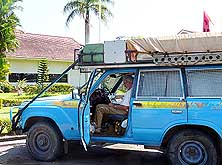
|
-
-

|
- 181
It is easy to spend some hours
- at the pool with ocean view at the
- luxury Horison Hotel in Bengkulu …..
|
- 182
..... occasionally we take
- advantage of Wi-Fi in the
- hotel’s parking lot
|
- 183
Five on a motorbike is quite
- common. We have spotted also six
|
-
- Very early next morning, Emil drives to the gasoline station, because we urgently need
now to stock up on fuel. Shortly after, he is back without having achieved anything. Not
too happy he tells me that there is again no fuel available and that the lined up cars are
gone! What is happening? It is not too difficult to guess. Along the coastal road a mafia
has established. As soon as the supply tanker arrives – what mostly happens in the
middle of the night – the locals immediately buy off all the fuel to sell it
afterwards in plastic bottles along the road for Rp. 1’500 (=US$ 0.17) more expensive
than at the filling pump. It suddenly dawned on us why yesterday we found the only station
along the road empty too. We do not bother so much about the price difference, but the
risk to get watered stuff. But having no other choice, we fill at least one of our 20-lt.
jerrycans. Then we say good-bye to the surfer paradise, where we actually intended to
relax for a few days at the beach. But it is definitely not our place!
|
-
-
-
-

|
-
-

|
-
-
-
-

|
- 184
An idyllic quiet scenery South of
- Bengkulu: Fishing boats mooring at
- the bank of a meandering river …..
|
- 185
..... no catch! The
- fisherman will throw out
- his net elsewhere again
|
- 186
A settlement squeezed between
- the ocean and rice fields in the evening
- light near the coastal village of Krui
|
-
- For some time, we still follow the West coast. After around 12 miles from Krui, we
branch off to the East and towards the mountains. Driving through a village, the sound of
music reaches our ears and then we spot the dancing on a schoolyard. Until we get out of
the car and reach the crowded place the group already retreats. A young mother carrying a
child encourages us to come closer and beckons us to wait. She hurries away and seconds
after, the dancers, specially dressed and painted, reappear and perform once more just for
the two of us. We are really touched how people here let us unconditionally take part in
their lives. At the end, the whole spectators gather at the roadside to wave us good-bye.
|
-
-

|
-
-

|
-
-

|
- 187
In the South of Sumatra’s
- West coast, near the coastal village
- of Krui, the sandy beaches start –
- one more beautiful than the other
|
- 188
The ball of the setting sun
- shines through palm trees, when
- we approach the surfer paradise
- of Krui in the South
|
- 189
A deserted coast North of Krui
|
-
- Shortly afterwards, the road climbs once more steadily and right on the top our gasoline
runs out. The space to pull aside is very limited what means that we have to pour in the
20 lt. of our jerrycan fast into the tank, because the heavy trucks passing by show no
mercy. They drive past us very closely and that without reducing their speed. Is it not
often the case that exactly then something goes wrong when you are under extreme time
pressure? In any case, when Emil wants to start with the procedure, he sees that the fuel
filler neck which we did not use for a long time is rusted through. This means that we
have to make an improvisation. We do it the African way by pulling over a sleeve cut from
a plastic bottle we find on the roadside and wrap the whole thing thickly with tape.
|
-
-

|
-
-

|
-
-
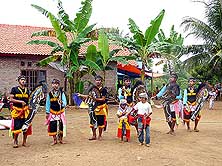
|
- 190
A band plays to a performance
- of boys at a school ground in a
- small country village .....
|
- 191
….. the face of
- a dancer shows the
- special make-up …..
|
- 192
….. the dancers in their
- traditional costumes show their skills
|
-
- And, what a relief, it works and the fuel is gargling slowly into our tank, only in
stages though, as Emil has to hurry aside to save his life each time a truck thunders
past. Such a simple action as filling spare fuel into a vehicle tank can suddenly become a
war of nerves. Now we can only hope that it is true that in the next bigger village of
Wonosobo there are four gasoline stations and that there not everything will be sold out
again. Until we reach it though, it will take some time because we hardly start driving
again when three trucks are blocking the road. One of them, carrying a high load on the
roof, got off the pavement and lies aside in a frightening inclined position. The two
others try simultaneously to lift it back to the road with steel cables. We really think
that it will tip over, but surprisingly it does not. It is again like in Africa: Everybody helps everybody, and we are always astonished
how such delicate situations mostly find a good end. In this respect they are true masters
in third world countries. Improvising has to be learnt!
|
-
-

|
-
-

|
-
-

|
- 193
Typically for a Muslim country:
- Women and girls are watching the
- performances from one side …..
|
- 194
….. and men and boys
- from the another side
|
- 195
At the Southwest coast, we pass
- some homes with attached Hindu
- temples as found on the island of Bali
|
-
- We probably seldom were happier to encounter a gasoline station, particularly one with
fuel! We bunker 100 lt. and then head straight to Bandar Lampung, the fourth biggest and
most Southerly town in Sumatra. It is the place, where in 2007 – coming from Java – our first Sumatra journey found an abrupt
end when a differential fracture made us return to Jakarta. This time there is a surprise
of a different kind waiting for us. Due to the article “Die
Uneinholbaren” – “the Uncatchables” – published in the German
”Frankfurter Allgemeine Zeitung” not only enthusiastic fans contacted us but
also TV stations. Therefore it happens that on June 25th, 2010, a 3-men-crew of
Germany’s ARD TV station flies in from Singapore for an interview in their section
“Nachtmagazin” (night magazine). They are accompanied by Nina, a co-worker from
Jakarta, and three local guys familiar with the city of Bandar Lampung. What a delegation!
With three cars we cross the busy town mid-afternoon to a lovely beach with picturesque
fishing boats and a small offshore island where the interview is shot and broadcasted on
July 20th, 2010 under the title “Weltenbummler” (globetrotters). B.t.w.: The
broadcast has taken about 1 minute!
|
-
-

|
-
-
-
-

|
-
-

|
- 196
Three trucks block the road at a
- mountain pass – not unusual in Sumatra.
- Two try to rescue their “colleague” that
- went off the road with steel cables,
- what they manage surprisingly fast
|
- 197
On a mountain pass, we run
- out of fuel. Emil is pouring our last
- 5 gallons from a jerry can into the tank
|
- 198
In the rainforest, we
- always discover new
- tropical flowers
|
-
- Next day our LandCruiser suddenly goes on strike. On our drive through the busy city
center the engine dies without any forewarning, but revives again after continuously
trying to start it. And it happens not only once. What’s the reason? “May be it
is the distributor”, Emil guesses. We have not changed the contacts for quite some
time, to be precise since Hong Kong. According to
Emil’s statistics the replacement took place exactly 14’708 miles ago. He seems
right with his diagnose because after we replaced it and at the same time also the
condenser, the problem seems to be solved. As there is a Toyota distributor close-by, we
decide to stock up on these parts again. We pull the No. 58 at the customers’
service. No. 57 is already being served, thus it will not take long until it will be our
turn, we think. Completely wrong! Despite that four consultants are sitting behind their
desks, no one pushes the button anymore. No. 57 remains. In secret we smile because we
exactly know the reason. Nobody wants to serve us because they hardly speak any English.
They prefer to shuffle around papers from one side to the other on their desk or occupy
themselves with unimportant things. Finally, a girl takes pity on us and she then attends
us competently. From this very moment the numbers change without delay. When we close the
door behind us, No. 65 is already flashing.
NB: It was neither the contacts of the distributor nor its condenser, because the problem
restarted the first day in Papua New Guinea again. A loose
cable was found eventually after a long search in the cable tangle below the dashboard!
|
-
-

|
-
-

|
-
-

|
- 199
Colorful fishing boats and a tiny
- offshore island in Bandar Lampung, the
- southernmost town in Sumatra, is the
- backdrop for the ARD interview that
- has been broadcasted in Germany in
- their“Nachtmagazin” during the news
- on July 20th, 2010 …..
|
- 200
..... the German 3-men-crew
- who flew in from Singapore, is
- shooting how Liliana improvises a
- meal with corned beef and peas …..
|
- 201
..... a picture to remember the
- ARD crew on the parking of our
- Hotel in Bandar Lampung
|
-
- Eleven days to go before our planned shipment to PNG and we still are not one step
further. At least, after many more emails, we are a bit wiser: Apparently, the Ministry of
Tourism got only verbal assurances from the different authorities, but no written permits
– no wonder that we never received any copies! What does that concretely mean for us?
Shall we stick our heads in the sand, overcome our skepticism and just venture it? We are
on the fence what to do and decide to continue for now our journey towards Jakarta,
hitting our last 50 miles on Sumatra’s roads. In Kalianda, about 20 miles before the
ferry terminal of Bakauheni-Merak, we check in at the same hotel we did three years ago,
and surprisingly there is still somebody there who remembers us. Elections for new
governors will shortly take place and the propaganda campaign is running full speed.
Scores of motorbikes, decorated with little flags are thundering up and down the village
streets, hooting and shouting.
|
-
-

|
-
-

|
-
-

|
- 202
A cyclist rolls unhurriedly along
- Kalianda’s beach, the last village
- before the ferry terminal of Bakauheni,
- where the ferries sail to Java
|
- 203
We park between piles
- of rubbish at the otherwise
- lovely beach of Kalianda
|
- 204
Locals drive back from
- the beach to their settlement
|
-
- Apart from that, the place is still as quiet as we remember it. There is just one thing
that changed: The sandy beach is definitely covered with more rubbish. That doesn’t
seem to bother the locals at all: Family fathers are fishing with their boys at the quiet
lagoon or lead their children by motorbike to the beach to play; a woman collects
tirelessly wood, which was washed ashore; a cyclist enjoys his ride along the sea shore;
screaming youngsters amuse themselves with the breaking waves and young couples look for a
quiet spot offside. Such is island life today, such it was yesterday and such it will be
tomorrow!
|
-
-
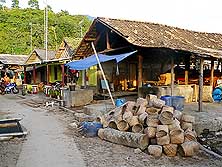
|
-
-
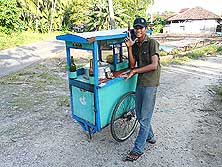
|
-
-
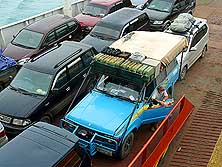
|
- 205
A cluster of peaceful fishermen
- houses along Kalianda’s coast
|
- 206
A mobile kitchen in the village of
- Kalianda. With a connected gas con-
- tainer, food is prepared freshly on the spot
|
- 207
Emil relaxes beside our car
- on the ferry from Bakauheni
- in Sumatra to Merak in Java
|
-
- The hills are shrouded in mist, rice and grain fields are spreading on both sides of the
road for the last 20 miles on Sumatra’s road to the ferry terminal of Bakauheni. It
is July 1st, 2010. There is little activity, thus we are able to board immediately the
next leaving ferry to Merak on Java. A quarter of an
hour later, we are already sailing. When the mountainous backdrop of Sumatra slowly
disappears, we experience this strange feeling we mostly sense when another episode of our
epic journey ends. There are a few things though we did not like in Sumatra, e.g. the
handling of the environment, the incredible piles of rubbish laying around, the
nerve-racking noise level and last but not least the mostly potholed roads that need the
drivers attention 100%.
|
-
-

|

|
-
-

|
- 208
Like already three years ago, a
- dealer is selling also this time a liquid for
- healing or stimulating in small bottles. Is it
- obtained from alive mantas displayed here?
|
- 209
Cheerfully passengers pose
- for a picture to remember on the
- ferry from Sumatra to Java
|
- 210
We are back on the congested
- streets of Jakarta. Since 2007,
- it did not get any better
|
-
- However, there are also many things we did like and which enriched our lives: We think
especially at Danau Toba Crater Lake, where we spent a relaxed time, at the lush rice
fields that accompanied us for many miles, at the Highland People of North and West
Sumatra with their traditional culture and architecture and their spontaneous invitations
to weddings. The deepest memory, however, will be the broad smiles of the people. In some
remote places it could happen that they looked at us as if we would come from another
planet, like UFO’s – “unidentified foreign objects”. In general, the
Indonesians are a lovable nation – it is just a pity that the language barrier is
mostly too big to get to know each other more closely.
|
-
-

|
-
-

|
-
-

|
- 211
Our LandCruiser sits in a „beauty
- parlor“ in Jakarta. In the efficient Sinar Jaya
- workshop, it gets a set of new tires (for the
- first time a Chinese brand named Boto!), a
- new battery and a new tarp for the roof …..
|
- 212
..... and we are presented each
- with a T-shirt of the „International
- Offroad Challenge“ and a jacket
- of the “Rainforest Challenge”
|
- 213
On July 7th, 2010, our LandCruiser is
- waiting in the container yard of our shipping
- agent in Jakarta for its 19th container, which
- will bring it on the freighter “Pacific Resolution”
- of the Swire Shipping Line “Tasman Orient” to
- Lae in Papua New Guinea – the 167th country
|
-
- P.S.: The following week we spend in Jakarta. It is a hectic rush. It is only here that
it becomes evident – after the exchange of 170 (!) emails - that we can take the
chance and the risk to ship to PNG, i.e. that the car
permits from Port Moresby should be ready. As this is fixed, the undertaking nearly fails
the last moment due to a container shortage, though we ordered it as a precaution already
weeks ago. Only the day before our departure to Malaysia, on July 7th, at 2.30pm, it is
delivered – after a lot of pushing from our side. Then finally we can relax and Emil
can drive our LandCruiser, equipped with a new set of Chinese tires, a new battery and a
new tarp into its 19th box and lash it. It will sail on July 22nd, with the freighter
"Pacific Resolution" of the “Swire Shipping Line” back to the Pacific, exactly to the port of Lae in Papua New Guinea. We will make a two week stopover in Kuala
Lumpur in Malaysia to continue with our teeth treatment, and
on July 26th, 2010, we will follow our travel buddy via Singapore
to the land of adventure.
|
-
|
|
To the previous website: Pictures from our
2010-Indonesian trip in West Sumatra in May and June 2010 |
|
|
- More websites from Indonesia and
Timor-Leste:
More websites from East Malaysia and
Brunei:
|
![]()





































































